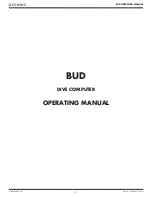
34
…7
MAINTENANCE
7.4.3
Intermittent Short Term Spikes
in Turbidity Readings
This is usually due to bubbles going through the light path within
the flowcell. These bubbles are as a result of degassing,
Degassing is not an instantaneous process and it is possible that
it is taking place after the sample has gone through the de-
bubbler. The bubbles start to form in the sample pipework and
the flowcell. As they grow gradually, the bubbles finally release
and flow through the light path, causing a spike in the turbidity
reading.
The transmitter can be programmed for Bubble Rejection, which
removes these short term spikes from the readings. – see
Section 6.3. For optimum operation the Cleaner should be
operated as frequently as possible to prevent bubbles building
up on the windows.
7.4.4
Care and Maintenance
of Dry Calibration Standards
•
Ensure that any residual moisture has been carefully
wiped off after use. It is essential that the Dry Calibration
Standard is always stored in the container provided
when not in use.
•
Avoid direct contact with the glass prism. Fingerprints on
the device could alter its stated value.
•
Clean the prism with a cotton, lint-free cloth.
•
The storage container includes a silica gel dryer. Replace
this dryer annually.
•
Return the Dry Calibration Standard to The Company
annually for checking.
Important Note.
When returning the Dry Calibration
Standard for checking, ensure that it is packed in the
original storage container.
7.4.5
Determination of the Dry Standard Value
for the 7997 300 and 400 Series Sensors
The dry standards supplied with the 7997 300 and 7997 400
series of systems are instrument specific. Therefore, if a
replacement dry standard is purchased, or if one has been
purchased subsequent to delivery of the system, then the value
of the standard has to be determined when used with the
specific system.
a) Follow the instructions in Section 5.2.2 for formazine
calibration.
b) Dry the sensor with care.
c) Insert the new dry standard and take note of the reading
obtained. This reading will be the value of the dry standard.
d) Mark the dry standard with this value.
7.4.6
Converting 7997 202 Sensor
to 7997 201 Sensor (with Integral Cleaning)
It may be necessary to upgrade from a wiperless 7997 202
sensor to a 7997 201 sensor with wiper. To upgrade the sensor
7997 202 proceed as follows:
a) Shut off sample water using the isolating valve installed
upstream of the sensor unit.
b) Drain the unit by closing the inlet and opening the drain valve.
Carefully remove the sensor unit top cap to aid complete
drainage. When the system is empty, close the drain valve.
c) Fit the new wiper unit and use the collar previously used to
secure the top cap. Wire the wiper cable into the turbidity
unit connection box – see Fig. 3.8 for connection details.
d) Change sensor type from 7997 202 to 7997 201 and set
clean interval – see Section 6.3 Set Up Parameter Page.
Note
. A calibration should be carried out before operating
the turbidity sensor.
e) Follow the Calibration procedure in Section 5.2.2.
Summary of Contents for 4670 Series
Page 1: ...Turbidity Systems 4670 Series User Guide IM 4670_13 ...
Page 49: ...47 NOTES ...
Page 50: ...48 NOTES ...
















































